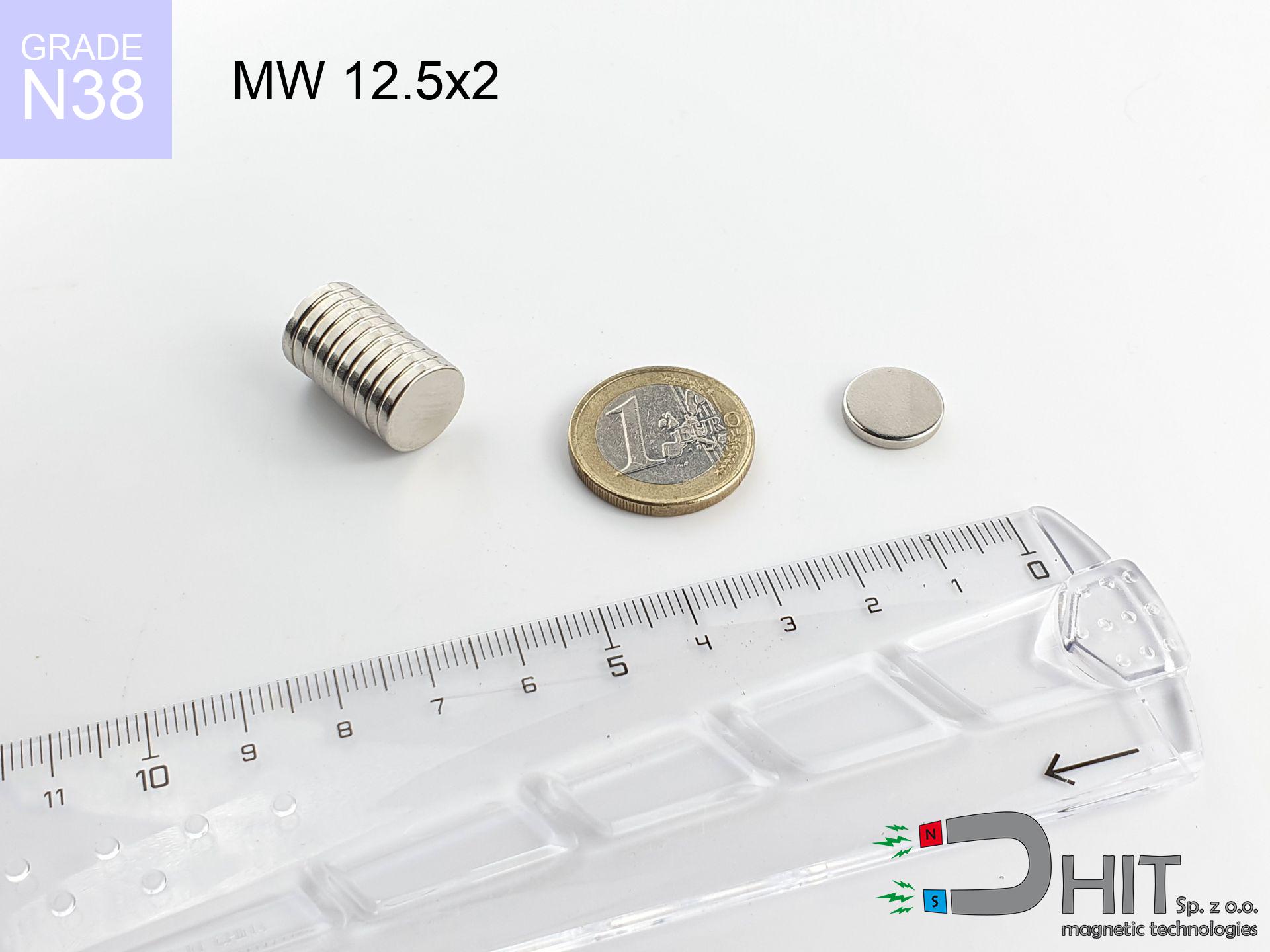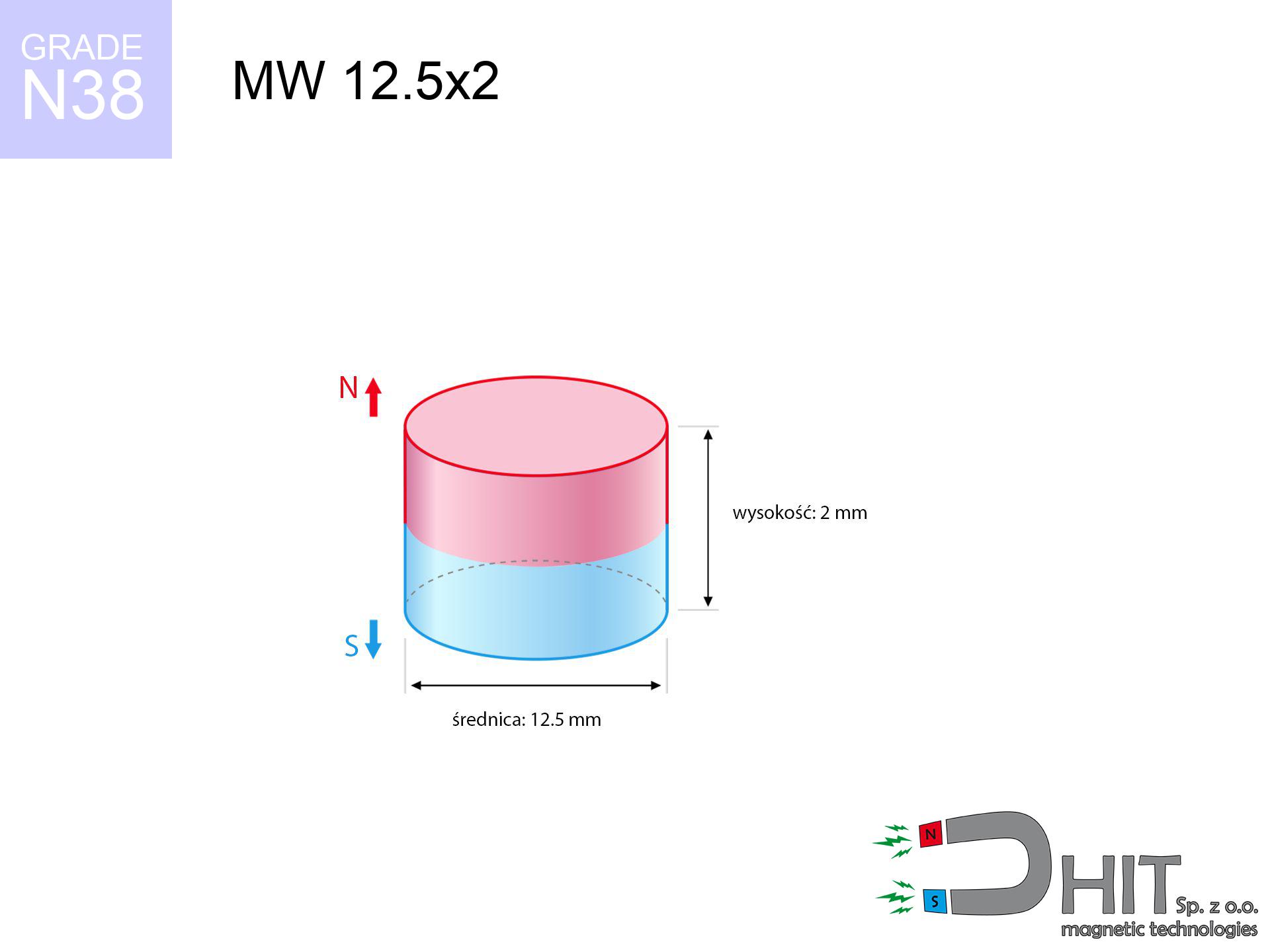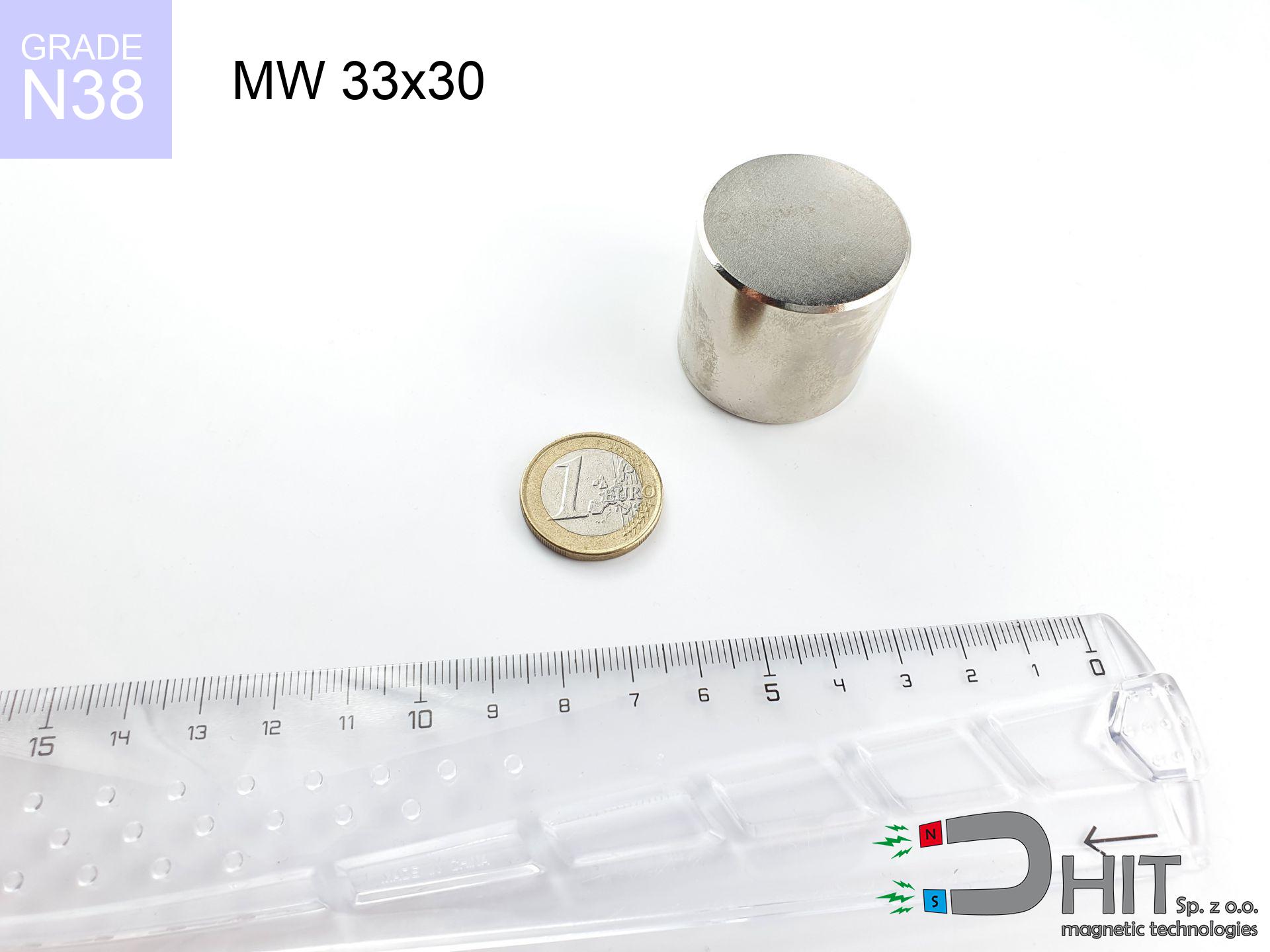MW 12.5x2 / N38 - cylindrical magnet
cylindrical magnet
Catalog no 010014
GTIN: 5906301810131
Diameter Ø [±0,1 mm]
12.5 mm
Height [±0,1 mm]
2 mm
Weight
1.84 g
Magnetization Direction
↑ axial
Load capacity
1.38 kg / 13.53 N
Magnetic Induction
188.88 mT
Coating
[NiCuNi] nickel
0.935 ZŁ with VAT / pcs + price for transport
0.760 ZŁ net + 23% VAT / pcs
0.690 ZŁ net was the lowest price in the last 30 days
bulk discounts:
Need more?Hunting for a discount?
Contact us by phone
+48 22 499 98 98
if you prefer send us a note by means of
inquiry form
through our site.
Lifting power along with form of magnetic components can be estimated on our
power calculator.
Order by 14:00 and we’ll ship today!
MW 12.5x2 / N38 - cylindrical magnet
Magnetic properties of material N38
Physical properties of NdFeB
Shopping tips
Moreover, although neodymium is a component of the strongest magnets, they are susceptible to corrosion in humid environments. For this reason, they are coated with a coating of nickel to increase their durability. It's worth noting that NdFeB neodymium magnets are about 13% lighter than SmCo magnets and, despite their power, are brittle, which requires care during their handling. For this reason, any mechanical processing should be done before they are magnetized.
In terms of safety, there are several recommendations regarding the use of these magnets. They should not be used in acidic, basic, organic environments or where solvents are present, and also in water or oil. Additionally, they can damage data on magnetic cards and hard drives, although data deletion using a neodymium magnet is not guaranteed.
In terms of properties in different environments, neodymium magnets are sensitive to corrosion, especially in humid conditions. Therefore, they are often covered with coatings, such as epoxy, to preserve them from external factors and extend their lifespan. High temperatures exceeding 130°C can result in a reduction of their magnetic properties, although there are particular types of neodymium magnets that can tolerate temperatures up to 230°C.
As for potential dangers, it is important to avoid using neodymium magnets in acidic environments, basic conditions, organic or solvent environments, unless they are adequately insulated. Additionally, their use is not recommended in wet conditions, oil, or in an environment containing hydrogen, as they may lose their magnetic properties.
Advantages and disadvantages of neodymium magnets NdFeB.
Besides their magnetic performance, neodymium magnets are valued for these benefits:
- They virtually do not lose power, because even after ten years, the decline in efficiency is only ~1% (according to literature),
- They are extremely resistant to demagnetization caused by external magnetic sources,
- Because of the lustrous layer of silver, the component looks high-end,
- The outer field strength of the magnet shows remarkable magnetic properties,
- Neodymium magnets are known for very high magnetic induction and the ability to work at temperatures up to 230°C or higher (depending on the shape),
- The ability for custom shaping and adaptation to custom needs – neodymium magnets can be manufactured in multiple variants of geometries, which enhances their versatility in applications,
- Wide application in cutting-edge sectors – they are utilized in computer drives, electric motors, clinical machines as well as sophisticated instruments,
- Relatively small size with high magnetic force – neodymium magnets offer strong power in small dimensions, which allows for use in miniature devices
Disadvantages of neodymium magnets:
- They may fracture when subjected to a sudden impact. If the magnets are exposed to mechanical hits, it is advisable to use in a metal holder. The steel housing, in the form of a holder, protects the magnet from cracks while also strengthens its overall resistance,
- Magnets lose power when exposed to temperatures exceeding 80°C. In most cases, this leads to irreversible performance loss (influenced by the magnet’s form). To address this, we provide [AH] models with superior thermal resistance, able to operate even at 230°C or more,
- Magnets exposed to humidity can rust. Therefore, for outdoor applications, we recommend waterproof types made of non-metallic composites,
- Limited ability to create threads in the magnet – the use of a magnetic holder is recommended,
- Possible threat related to magnet particles may arise, if ingested accidentally, which is notable in the protection of children. Additionally, minuscule fragments from these products have the potential to disrupt scanning if inside the body,
- Higher purchase price is one of the drawbacks compared to ceramic magnets, especially in budget-sensitive applications
Best holding force of the magnet in ideal parameters – what it depends on?
The given lifting capacity of the magnet corresponds to the maximum lifting force, measured under optimal conditions, specifically:
- using a steel plate with low carbon content, acting as a magnetic circuit closure
- with a thickness of minimum 10 mm
- with a refined outer layer
- in conditions of no clearance
- in a perpendicular direction of force
- in normal thermal conditions
Key elements affecting lifting force
Practical lifting force is determined by factors, by priority:
- Air gap between the magnet and the plate, as even a very small distance (e.g. 0.5 mm) causes a drop in lifting force of up to 50%.
- Direction of applied force, because the maximum lifting capacity is achieved under perpendicular application. The force required to slide the magnet along the plate is usually several times lower.
- Thickness of the plate, as a plate that is too thin causes part of the magnetic flux not to be used and to remain wasted in the air.
- Material of the plate, because higher carbon content lowers holding force, while higher iron content increases it. The best choice is steel with high magnetic permeability and high saturation induction.
- Surface of the plate, because the more smooth and polished it is, the better the contact and consequently the greater the magnetic saturation.
- Operating temperature, since all permanent magnets have a negative temperature coefficient. This means that at high temperatures they are weaker, while at sub-zero temperatures they become slightly stronger.
* Lifting capacity was assessed with the use of a polished steel plate of suitable thickness (min. 20 mm), under perpendicular pulling force, in contrast under shearing force the lifting capacity is smaller. In addition, even a small distance {between} the magnet’s surface and the plate lowers the load capacity.
Exercise Caution with Neodymium Magnets
Magnets should not be treated as toys. Therefore, it is not recommended for children to have access to them.
Neodymium magnets are not toys. Be cautious and make sure no child plays with them. In the case of swallowing multiple magnets simultaneously, they can attract to each other through the intestinal walls. In the worst case scenario, this can lead to death.
Neodymium magnets are the strongest magnets ever created, and their strength can surprise you.
On our website, you can find information on how to use neodymium magnets. This will help you avoid injuries and prevent damage to the magnets.
Magnets made of neodymium are especially fragile, resulting in shattering.
Magnets made of neodymium are fragile and will crack if allowed to collide with each other, even from a distance of a few centimeters. Despite being made of metal and coated with a shiny nickel plating, they are not as hard as steel. In the case of a collision between two magnets, there can be a scattering of small sharp metal fragments in different directions. Protecting your eyes is essential.
Neodymium magnets can become demagnetized at high temperatures.
Although magnets have demonstrated their effectiveness up to 80°C or 175°F, the temperature can vary depending on the type, shape, and intended use of the specific magnet.
Magnets will attract to each other, so remember not to allow them to pinch together without control or place your fingers in their path.
If have a finger between or alternatively on the path of attracting magnets, there may be a serious cut or even a fracture.
The magnet is coated with nickel - be careful if you have an allergy.
Studies show a small percentage of people have allergies to certain metals, including nickel. An allergic reaction often manifests as skin redness and rash. If you have a nickel allergy, try wearing gloves or avoid direct contact with nickel-plated neodymium magnets.
Do not bring neodymium magnets close to GPS and smartphones.
Neodymium magnets generate strong magnetic fields that interfere with magnetometers and compasses used in navigation, as well as internal compasses of smartphones and GPS devices.
Dust and powder from neodymium magnets are flammable.
Avoid drilling or mechanical processing of neodymium magnets. If the magnet is crushed into fine powder or dust, it becomes highly flammable.
Make sure not to bring neodymium magnets close to the TV, wallet, and computer HDD.
Neodymium magnets generate intense magnetic fields that can destroy magnetic media such as floppy disks, video tapes, HDDs, credit cards, magnetic ID cards, cassette tapes, etc. devices. They can also destroy videos, televisions, CRT computer monitors. Remember not to place neodymium magnets close to these electronic devices.
Keep neodymium magnets away from people with pacemakers.
Neodymium magnets generate strong magnetic fields. As a result, they interfere with the operation of a pacemaker. This happens because such devices have a function to deactivate them in a magnetic field.
Pay attention!
Please read the article - What danger lies in neodymium magnets? You will learn how to handle them properly.







![AM ucho [M8] - magnetic accessories AM ucho [M8] - magnetic accessories](https://cdn3.dhit.pl/graphics/products/am-ucho-m8-lib.jpg)

